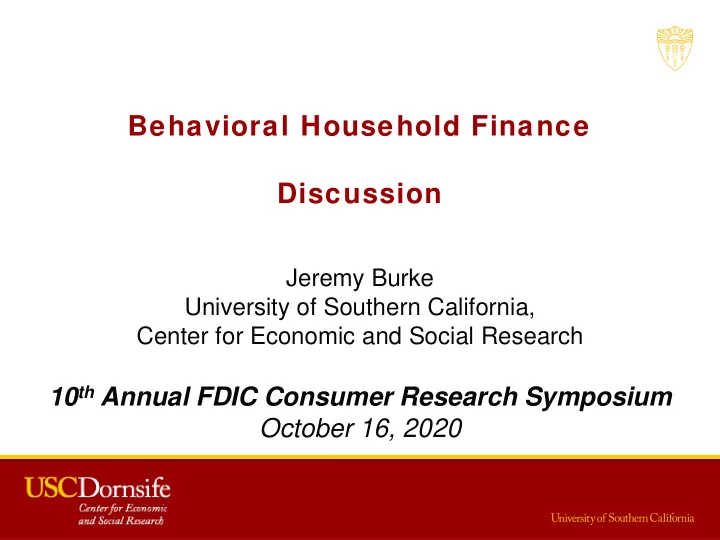

Behavioral Household Finance Discussion Jeremy Burke University of Southern California, Center for Economic and Social Research 10 th Annual FDIC Consumer Research Symposium October 16, 2020
Two really nice contributions • William L. Skimmyhorn and Richard W. Patterson (2020) “How do Behavioral Approaches to Increase Savings Compare? Evidence from Multiple Interventions in the U.S. Army” • Daniel Ben-David, Ido Mintz, and Orly Sade (2020) “Using AI and Behavioral Finance to Cope with Limited Attention and Reduce Overdraft Fees”
Similar Notable Strengths • Important questions of interest to both academics and policymakers • Causal identification from field (quasi-) experiments – Very large sample sizes -> allows precise estimates of impacts • Real world settings • High quality administrative data • Well executed papers
Behavioral Approaches to Increase Savings Summary • Examines several classes of interventions in U.S. Army – Behavioral messaging (randomized) – Savings targets (randomized) – Active choice (quasi-experimental) – Automatic enrollment (quasi-experimental) • Same employer -> institutional settings held constant • Effects on TSP participation , contributions, balances
Behavioral Approaches to Increase Savings Summary • Increases in participation rate – Behavioral messaging: 0.41pp (6%) – Savings targets: 0.69pp (9%) – Active choice: 10.68pp (104%) – Automatic enrollment: 37.28pp (208%) • Generally validates previous findings (estimates on low side) • More validation/replication studies needed!
Behavioral Approaches to Increase Savings Comments • Unique institutional setting has advantages and drawbacks – Institutional features interact with interventions? • And effect relative effect sizes? • Estimated effects of AE on participation from lit: 28pp – 70pp • Active choice: 23pp (Carroll et al., 2009) • Different (relative) effect sizes for different sized employers?
Behavioral Approaches to Increase Savings Comments • Active choice implementations yield different effects? – Briefings – Return form (similar to Carroll et al., 2009) – Parallel trends across treatment and control sites? • Introduction of AE part of retirement system overhaul – Reduced generosity of DB pension ( ↑ ) – 1% automatic employer contribution (↔) – (Future) employer match ( ↑?) – 2017 starts choose across retirement systems ( ↓?)
Behavioral Approaches to Increase Savings Comments • Cost-effectiveness (more papers should do this!) – Active choice more cost effective for smaller firms – AE more effective for very large firms • Light touch emails cost $5,000 for next firm to implement? – “Many [employees] like you start by contributing at least X% of their [paycheck] into a traditional or Roth [401k]“ • Would most firms implement active choice via briefings? • Cost estimate appears to be static? – With 10% annual employee turnover, AE more cost effective for a 750 employee firm after 6 years
AI, Behavioral Finance, and Overdrafts Summary • Used AI to target a sample of Mint users at risk of overdraft • Randomized into 4 groups – Control (no messages) – Base (original messages) – Simplified Avoid (negative framing) – Simplified Save (positive framing) • Messages reduced overdrafts during 4 month intervention – Base by 3% (0.26 overdrafts) – Simplified avoid by 9% (0.72 overdrafts) – Simplified save by 5% (0.40 overdrafts) – Effects concentrated among higher income Minters
AI, Behavioral Finance, and Overdrafts Comments
AI, Behavioral Finance, and Overdrafts Comments • Over the full experiment, intervention only effective for higher income Minters – Systematic differences in number of overdrafts across income categories • Look at no overdraft indicator? – AI better at predicting overdrafts among high income Minters? – Control for and look at interaction effects with prior overdrafts? • Mechanisms? – Reduced consumption? – Increased borrowing? – Better financial management (transfers)?
AI, Behavioral Finance, and Overdrafts Comments • Helpful to see a balance table – Income – Prior overdrafts? • Also helpful to see regression specs for simplified save vs. control – Can have one specification with each treatment and compare across treatments • Income heterogeneity sample size appears considerably larger than main effects sample size?
Recommend
More recommend